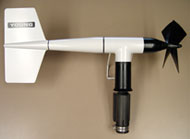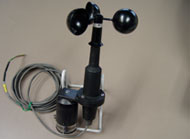WSPD
Average Wind Speed (10 m)
The 5-minute average wind speed at a height of 10 meters above the ground. The propeller has a starting threshold of 1 m s-1.
- The average wind speed is independent of the wind direction.
- When WSPD is zero, all other wind variables are set to zero.
| Type | Sensor Used | Standards Units | Accuracy |
| Standard - Primary | RM Young Wind Monitor, PDF | meters per second (m s-1) | ± 0.3 m s-1 |

RM Young Wind Monitor Sensor
WDIR
Average Vector Wind Direction (10 m)
The vector average wind direction at a height of 10 meters above the ground. Note: wind direction always describes the direction from which the wind is blowing. The vane has a starting threshold of 1.1 m s-1.
- When WSPD is zero, all other wind variables are set to zero.
| Type | Sensor Used | Standards Units | Accuracy |
| Standard - Primary | RM Young Wind Monitor, PDF | Described in degrees in a circle (from true north), where north is 0 degrees, east is 90 degrees, south is 180 degrees, and west is 270 degrees | ±3° (degrees) |

RM Young Wind Monitor Sensor
WMAX
Maximum Wind Speed (10 m)
The maximum (or peak) 3 second wind speed observed during a 5-minute interval at a height of 10 meters above ground; it is the largest value observed during the 5 minute averaging interval.
- WMAX is independent of wind direction.
| Type | Sensor Used | Standard Units |
| Standard - Primary | RM Young Wind Monitor (for Wind Speed), PDF | meters per second |

RM Young Wind Monitor Sensor
WS2M
Average Wind Speed (2 m)
The 5-minute average wind speed at 2 meters. Because of the characteristic response of the cup design, the Mesonet's dataloggers add 0.2 m s-1 to each observation greater than 0.2 m s-1.
- The cup anemometer only counts the rotations of the sensor caused by the speed of the wind; it does not measure wind direction. Its range is from 0.5 to 50 m s-1 and it can withstand gusts of 60 m s-1. The two-meter windspeed mainly is used for agricultural purposes (e.g., to help estimate evapotranspiration of moisture from the soil).
| Type | Sensor Used | Standard Units |
| Standard - Primary | RM Young Wind Sentry (for Wind Speed), PDF | m s-1 |

RM Young WInd Sentry Sensor
WVEC
Average Vector Wind Speed (10 m)
The average wind velocity (speed and direction accounted for) at a height of 10 meters above the ground.
- Note that this is a vector average (i.e., the wind direction is considered). If the wind is out of the north at 10 m s-1 for 2.5 minutes and then out of the south at 10 m s-1 for 2.5 minutes, the average vector wind velocity will be zero during that 5-minute period.
| Type | Sensor Used | Standard Units |
| Standard - Primary | RM Young Wind Monitor (for Wind Speed), PDF | meters per second |

RM Young Wind Monitor Sensor
WSSD
Wind Speed Standard Deviation (10 m)
The standard deviation of the wind speed at a height of 10 meters above the ground.
- This variable is a measure of the steadiness of wind speed. A small standard deviation indicates the wind generally blowing at the same speed; a large standard deviation indicates significant changes in wind speed during the 5-minute interval. The standard deviation may be large for inclement weather.
| Type | Sensor Used | Standard Units |
| Standard - Primary | RM Young Wind Monitor (for Wind Speed), PDF | meters per second |

RM Young Wind Monitor Sensor
WDSD
Wind Direction Standard Deviation (10 m)
The standard deviation of the wind direction at a height of 10 meters above the ground.
- This variable is a measure of the steadiness of wind direction. A small standard deviation indicates the wind is blowing from the same direction; a large standard deviation indicates significant changes in wind direction during the 5-minute interval. The standard deviation may be large for either inclement weather or relatively light winds.
| Type | Sensor Used | Standard Units |
| Standard - Primary | RM Young Wind Monitor, PDF | degrees |

RM Young Wind Monitor Sensor